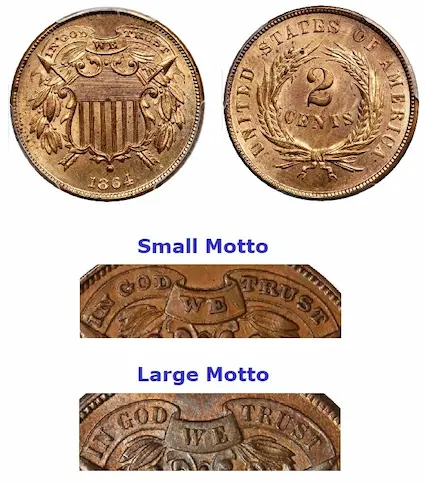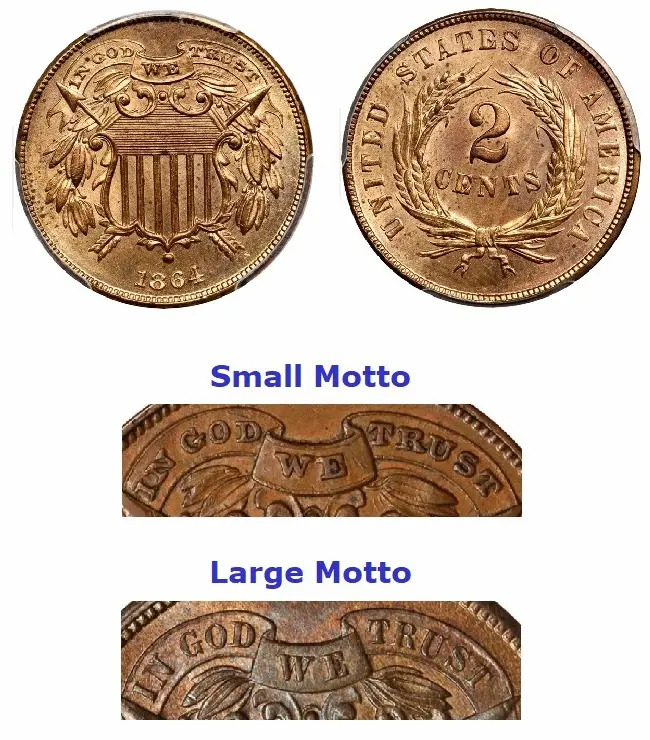1864 Shield Two Cent, Small Motto
The first salvos of the Civil War were fired at Fort Sumter, S.C. in April 1861. Less than two years later, most coinage had vanished from circulation in the East and Midwest, as people clung to gold and silver as a “safe harbor” during those perilous, uncertain times. Even copper and nickel coins were being hoarded.(1)
Frustrated by the lack of federal coinage, several enterprising individuals tried a bold innovation: strike tokens made of cheaper bronze, valued at one cent in goods, services, or money. The lighter, cent-sized “Civil War tokens” were readily accepted by the public as a medium of exchange, despite their metallic intrinsic value well below that of one cent.(2)
Up until this time, the United States Mint had incorrectly presumed underweighted coins would be rejected in commerce. The popularity of the tokens convinced the Mint to copy the idea. Work began to convert the thick, copper-nickel Indian Head cent to a thinner coin made of bronze, in anticipation it would not be hoarded and circulate freely. Also under consideration was a bronze two-cent piece.
Mint Engraver James B. Longacre fashioned a theme for the proposed two-cent coin featuring an obverse heraldic shield and arrows with a wheat wreath reverse. Before the final design was adopted, another modification was added, one of an enduring nature...
As thousands of men were dying on the battlefields of the Civil War, many turned their eyes to Heaven for perseverance and divine intervention. In response to the religious fervor sweeping the nation, the Reverend Mark R. Watkinson wrote to Treasury Secretary Salmon Chase pleading to insert the “the recognition of the Almighty God in some form on our coins.”
Chase agreed, and the motto IN GOD WE TRUST was added to the two-cent coin obverse. It was the first U.S. coin to bear this inscription and the tradition has carried forward to the present day, although it wasn’t until 1955 when legislation was passed requiring the wording on all U.S. coins.
The Shield Two Cent coin went into production in 1864. The first pieces of the new design were struck with an obverse die made from a prototype hub utilizing smaller letters for the IN GOD WE TRUST motto. The prototype hub was quickly replaced with another having larger letters.(3)
Of the 20 million two-cent pieces struck in 1864, the vast majority of them were of the “Large Motto” variety. For many years, collectors paid little attention to the size difference in the mottos, but when it was finally noted and appreciated, the “Small Motto” became a classic rarity in American numismatics, and IN THAT WE TRUST it will forever be.(4)
| Estimated survivors in all grades: 10,300 ?
The survivor estimate from PCGS represents an average of one or more experts' opinions as to how many examples survive of a particular coin in all grades. Survival estimates include coins that are raw, certified by PCGS, and certified by other grading services. Learn more at PCGS. |
| PCGS Rarity Scale: 2.9 ?
The 'PCGS CoinFacts Rarity Scale' assesses the relative rarity of all U.S. coins, based on estimated surviving examples. The scale runs from 1.0 to 10.0. The higher the number, the rarer the coin.
Learn more at PCGS. |
| Search for the 1864 Shield Two Cent, Small Motto on eBay** |
Preview of eBay selection:
 |
|
| Trendline Avg = 9.47 | CLASSIC RARITY |
 |
|
| Trendline Avg = 9.47 | CLASSIC RARITY |
Historic Value Trend Charts:
| Last updated 2-5-25 | Return to Key Date Coin List | |
| Compare to Common Date Coin of Same Type | ||
|
|
||
| Download Charts to Your Computer | ||
Sources
1. Stack's Bowers Galleries. 1864 Two-Cent Piece. Small Motto. Aug 2019 Auction.
2. NGC. History of the Shield Two Cents.
3. Heritage Auctions. 1864 2C Small Motto. Aug 2018 Auction.
4. Garrett, Jeff and Guth, Ron. 100 Greatest U.S. Coins, 5th ed. Pelham, AL: Whitman Publishing, 2019.
**Many very fine coin dealers sell on eBay. At any point in time, there may be over one million search results for United States coins. This includes quite a few of the recommendations on our Key Date Coin List.
If you’re thinking about purchasing a rare coin, eBay is certainly worth a look. For your convenience, the links from this site to eBay are coded to bring up only coins certified by PCGS and NGC.
As is always, always the case, never buy a valuable coin from a seller whose trustworthiness cannot be verified. Learn more about this at our chapter Best Places to Buy Coins, which also has a section on doing business on eBay.
In the interest of full disclosure, Rare Coins 101 receives a small commission anytime someone connects to eBay from this site and purchases something.
Coin images by Stack's Bowers Galleries.


